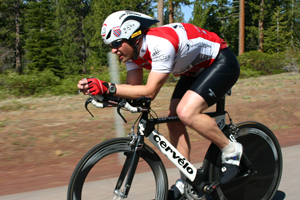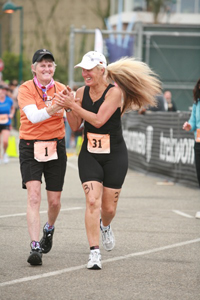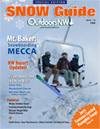The Evolution of the Triathlon
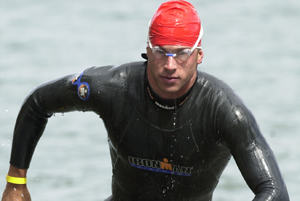
Participation mostly up but traditional disciplines may look different
By Hilary Meyerson
Photo at right: A racer exits the water during the Pacific Crest Triathlon. Photo courtesy of Dean Guernsey.
The first U.S. triathlon was held in San Diego in 1974, and the first Ironman race in Hawaii four years later. It’s been a long road to the Northwest since then, but multi-sport events are now an established part of the landscape.
The last decade has witnessed tremendous growth in this country’s triathlon participation. In 2010, an estimated 2.3 million unique individuals completed a triathlon. That represented a 55 percent growth in one year, according to the Sporting Goods Manufacturers Association (SGMA).
USA Triathlon (USAT) tracks this growth through membership numbers, which surpassed 150,000 annual members in 2011.
By comparison, annual membership hovered between 15,000 and 21,000 from 1993-2000. Some attribute the dramatic rise in interest in triathlon to the debut of it as an Olympic event in 2000 at the Sydney Games. Most agree that triathlons stepped into the spotlight at the turn of the millennium.
The promoter’s perspective
One group that has a front row seat to the triathlon show is BuDu Racing, LLC, owned by Rory and Deanna Muller of Auburn, Wash.
Rory caught the tri bug early; he’d been doing triathlons in the 80s. When he was laid off from Boeing in 2002, he took the opportunity to become an event promoter to put on his own races. His wife Deanna directs the communications, and Rory’s the course director. After 11 years of producing triathlons, Deanna is somewhat of an expert when it comes to offering some insights of her sport.
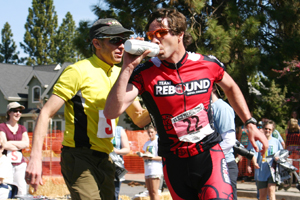
A runner hydrates during the run portion of the Pole Pedal Paddle race in Bend, Ore. Photo courtesy of Dean Boswell Photography.
“It has just continued to grow,” she said. “I think the biggest issue going on now is that there are so many races for participants to choose from. There are multiple races going on each weekend. As a promoter, we have to do more to meet the needs of the racers, as they have a choice.
“There’s a lot more interest in the longer distance (races) lately,” Deanna Muller added. “They are becoming more interesting to people. I think people are able to get fit so much quicker, and there are so many great coaches and trainers who can help people prepare for them. There are also a number of encouraging teams in the area, which creates an environment for people to train together, which is much more fun. (There is a) we’re all in this together kind of mentality.”
The shop-owner’s perspective
Reed Sillers, owner of Seattle triathlon store Speedy Reedy, has seen triathlon participation wax and wane with the economy.
“In the last 10 years, the sport has grown substantially, but I’ve also seen it drop in the last couple of years,” says Sillers, who has seen races that used to sell out now being canceled. He wonders aloud where those people are who used to be triathlon participants.
“From what I can see, the numbers are massive for the one-day adventure races,” said Sillers. “A lot of those races are driven by social media. There are lots of photos posted and (they have) more of a social atmosphere, whereas triathlon is a more individual sport.”
While some athletes might follow the latest trend in adventure races, Sillers’ core demographic of customers has stayed the same: people who are passionate about the sport and want to do it year after year.
One area that is a bright spot is the Ironman races.
“Every time they add an Ironman race, they fill up,” adds Sillers. “There is still a demand for that. They just moved Ironman Canada to Whistler, and that race filled up instantly a year in advance.”
The rise and fall of women’s triathlons
You can’t talk about women and triathlons without mentioning Sally Edwards. She was integral in the success of the Danskin Women’s
Triathlon Series that started in 1990. Triathlon was not an Olympic sport yet—it was still all about the Ironman triathlons. And, they were not kind or gentle events.
“It was all about the ‘Gruel-a-thon,’ as we called it,” recalls Edwards of the Ironman races. So, she and the Danskin folks started marketing that triathlons were for every BODY— every size, shape, age. And women responded. The Danskin Series shifted the focus from the competitive triathlon to a softer, gentle, experience.
The first Seattle Danksin was in 1993 and about 300 women participated.
“We embraced the last-place finisher as much as the first,” says Edwards who always accompanied the final finisher across the line. The Seattle race of the Danskin was always the Series’ biggest and almost always sold out.
However, recent years have seen a decline in the Seattle Danskin race. In 2010, there were 3,320 finishers; in 2011, it dropped to 2,037. And in 2012, there were just 1,529.
The Ironman Corporation recently purchased the Danskin Series and is replacing it with the Iron Girl Series for 2013. We have yet to see if this new ownership will change the landscape of women’s triathlons.
The new Seattle Iron Girl Triathlon is scheduled for Aug. 18 in Genesee Park, the site of the previous Danskin races.
Edwards speculates that the rise of novelty races (with themes from rock and roll to chocolate to costumed runs) may have hurt women’s triathlon participation. But the “novelty” participant is not the same woman.
“A triathlon is for the person who wants to train and be fit, and the novelty races are for people who want to have a fun weekend and mostly avoid training for it,” Edwards surmises.
For herself, she won’t stop participating anytime soon.
“I absolutely love triathlons.”
Future of multisport
Triathlons are not the only game in town—other multisport events are gaining in popularity as well. Events such as the Ski to Sea or the Pole Pedal Paddle races shift the focus from individual races to a relay or team event, incorporating skiing, kayaking and other sports into the mix.
Also, there are more training programs and coaching services available for those who want to take cross-training to cross-competing. Luckily, the Northwest has a wide range of options for those who want to challenge themselves in more than one discipline.
Multisports, whether it is the traditional swim/bike/run or ski/paddle/skate are here to stay. And safe to say, they will continue to change and evolve.
Hilary Meyerson is the editor of Outdoors NW, and has a few sprint triathlons under her belt.

